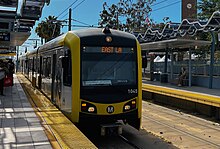
Back سكك مترو لوس أنجلوس Arabic লস অ্যাঞ্জেলেস কাউন্টি মেট্রো রেল Bengali/Bangla Metro v Los Angeles Czech Los Angeles Metro Rail German Metroo de Los-Anĝeleso Esperanto Metro de Los Ángeles Spanish متروی لس آنجلس Persian Los Angelesin metro Finnish Métro de Los Angeles French Los Angeles Metro Rail Hungarian
The Los Angeles Metro Rail is an urban rail transit system serving Los Angeles County, California, United States, consisting of six lines: four light rail lines (the A, C, E and K lines) and two rapid transit lines (the B and D lines), serving a total of 102 stations. The system connects with the Metro Busway bus rapid transit system (the G and J lines), the Metrolink commuter rail system, as well as several Amtrak lines. Metro Rail is owned and operated by the Los Angeles County Metropolitan Transportation Authority (Metro).
Los Angeles Metro Rail has been extended significantly since it started service in 1990, and several further extensions are either in the works or being considered. In 2023, the system had a ridership of 61,981,300 or about 208,300 per weekday as of the third quarter of 2024.
Los Angeles had two previous rail transit systems, the Pacific Electric Red Car and Los Angeles Railway Yellow Car lines, which operated between the late 19th century and the 1960s. The Metro Rail system uses many of their former rights of way, and thus can be considered their indirect successor.
- ^ "Transit Ridership Report Third Quarter 2024" (PDF). American Public Transportation Association. November 20, 2024. Retrieved November 23, 2024.
- ^ "Transit Ridership Report Fourth Quarter 2023" (PDF). American Public Transportation Association. March 4, 2024. Retrieved September 5, 2024.
- ^ Cite error: The named reference
FactsGlancewas invoked but never defined (see the help page).



